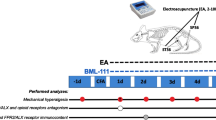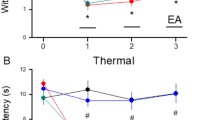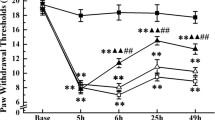Abstract
We have previously shown that electroacupuncture (EA) produced antinociception through the release of endogenous opioid peptides to activate opioid receptors during acute nociception. EA produced tolerance after its prolonged application. It has reported that 100 Hz EA could reduce mechanical hyperalgesia in complete Freund’s adjuvant (CFA)-induced inflammatory nociception rats. The present study aims to investigate the antinociceptive effect of EA and the development of EA tolerance in chronic inflammatory nociception rats with CFA injection into the hind paw plantar. The results showed that the antinociceptive effect of 100 Hz EA was significantly enhanced in CFA-induced inflammatory nociception rats. Naloxone at 20 mg/kg could significantly block this antinociceptive effect. Chronic tolerance to EA was developed faster in CFA-induced inflammatory nociception rats than in normal rats. Therefore, 100 Hz EA could enhance antinociceptive effects and accelerate tolerance development in CFA-induced inflammatory nociception rats. The enhancement of EA antinociceptive effect in CFA-induced inflammatory nociception rats might involve the endogenous opioid peptides such as dynorphin.



Similar content being viewed by others
References
Beyer A, Schafer M, Stein C (1997) Antinociceptive effects of dynorphin peptides in a model of inflammatory pain. Pain 70:141–147
Cabot PJ, Carter L, Schafer M, Stein C (2001) Methionine-enkephalin and dynorphin a release from immune cells and control of inflammatory pain. Pain 93:207–212
Colpaert FC (1979) Can chronic pain be suppressed despite purported tolerance to narcotic analgesia? Life Sci 24:1201–1209
Cook CD, Nickerson MD (2005) Nociceptive sensitivity and opioid antinociception and antihyperalgesia in Freund’s adjuvant-induced arthritic male and female rats. J Pharmacol Exp Ther 313:449–459
Goldstein A, Tachibana S, Lowney LI, Hunkapiller M, Hood L (1979) Dynorphin-(1–13), an extraordinarily potent opioid peptide. Proc Natl Acad Sci USA 76:6666–6670
Gutstein HB, Trujillo KA, Akil H (1995) Does chronic nociceptive stimulation alter the development of morphine tolerance? Brain Res 680:173–179
Han JS (2003) Acupuncture: neuropeptide release produced by electrical stimulation of different frequencies. Trends Neurosci 26:17–22
Han JS, Xie GX, Goldstein A (1984) Analgesia induced by intrathecal injection of dynorphin B in the rat. Life Sci 34:1573–1579
Huang C, Hu ZP, Long H, Shi YS, Han JS, Wan Y (2004) Attenuation of mechanical but not thermal hyperalgesia by electroacupuncture with the involvement of opioids in rat model of chronic inflammatory pain. Brain Res Bull 63:99–103
Huang C, Long H, Shi YS, Han JS, Wan Y (2005) Ketamine enhances the efficacy to and delays the development of tolerance to electroacupuncture-induced antinociception in rats. Neurosci Lett 375:138–142
Kayser V, Neil A, Guilbaud G (1986) Repeated low doses of morphine induce a rapid tolerance in arthritic rats but a potentiation of opiate analgesia in normal animals. Brain Res 383:392–396
Liang DY, Guo T, Liao G, Kingery WS, Peltz G, Clark JD (2006) Chronic pain and genetic background interact and influence opioid analgesia, tolerance, and physical dependence. Pain 121:232–240
Liu HX (1999) Repeated 100 Hz TENS for the treatment of chronic inflammatory pain in rats: optimal parameters and possible neurochemical mechanisms. Prog Physiol Sci 30:35–37
Millan MJ, Czlonkowski A, Pilcher CW, Almeida OF, Millan MH, Colpaert FC, Herz A (1987) A model of chronic pain in the rat: functional correlates of alterations in the activity of opioid systems. J Neurosci 7:77–87
Neil A, Kayser V, Gacel G, Besson JM, Guilbaud G (1986) Opioid receptor types and antinociceptive activity in chronic inflammation: both kappa- and mu-opiate agonistic effects are enhanced in arthritic rats. Eur J Pharmacol 130:203–208
Rahman AF, Takahashi M, Kaneto H (1994) Involvement of pain associated anxiety in the development of morphine tolerance in formalin treated mice. Jpn J Pharmacol 65:313–317
Ren MF, Han JS (1979) Rat tail-flick acupuncture method. Chin Med J 92:576–582
Shavit Y, Wolf G, Goshen I, Livshits D, Yirmiya R (2005) Interleukin-1 antagonizes morphine analgesia and underlies morphine tolerance. Pain 115:50–59
Spetea M, Rydelius G, Nylander I, Ahmed M, Bileviciute- Ljungar I, Lundeberg T, Svensson S, Kreicbergs A (2002) Alteration in endogenous opioid systems due to chronic inflammatory pain conditions. Eur J Pharmacol 435:245–252
Tian JH, Zhang W, Fang Y, Xu W, Grandy DK, Han JS (1998) Endogenous orphanin FQ: evidence for a role in the modulation of electroacupuncture antinociception and the development of tolerance to antinociception produced by morphine and electroacupuncture. Br J Pharmacol 124:21–26
Vaccarino AL, Marek P, Kest B, Ben-Eliyahu S Jr, Couret LC, Kao B, Liebeskind JC (1993) Morphine fails to produce tolerance when administered in the presence of formalin pain in rats. Brain Res 627:287–290
Acknowledgments
This work was supported by grants from the National Natural Science Foundation of China (30560145, 30600173 and 30570566), the Scientific and Technological Program of the Department of Education of Jiang-Xi Province, the “111” Project of the Ministry of Education of China and the “973” program of the Ministry of Science and Technology of China (2007CB512501).
Author information
Authors and Affiliations
Corresponding authors
Additional information
Special issue article in honor of Dr. Ji-Sheng Han.
Rights and permissions
About this article
Cite this article
Huang, C., Huang, ZQ., Hu, ZP. et al. Electroacupuncture Effects in a Rat Model of Complete Freund’s Adjuvant-Induced Inflammatory Pain: Antinociceptive Effects Enhanced and Tolerance Development Accelerated. Neurochem Res 33, 2107–2111 (2008). https://doi.org/10.1007/s11064-008-9721-x
Received:
Accepted:
Published:
Issue Date:
DOI: https://doi.org/10.1007/s11064-008-9721-x




